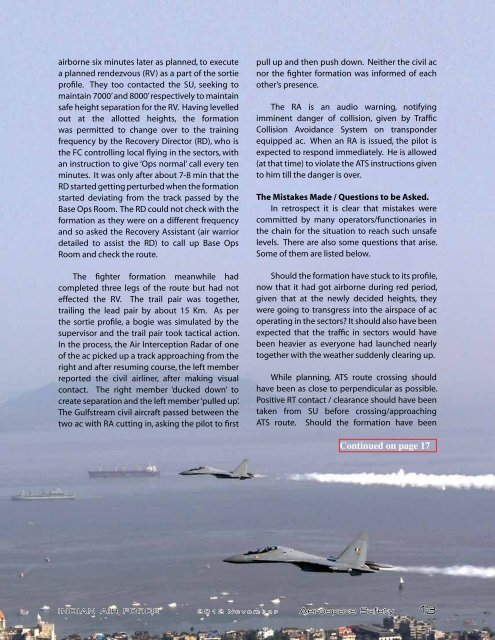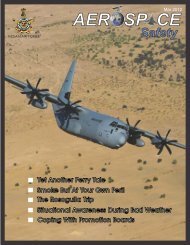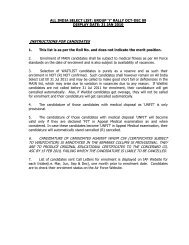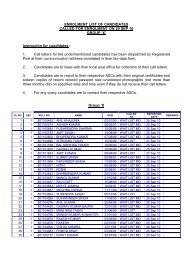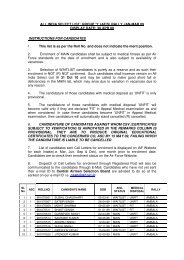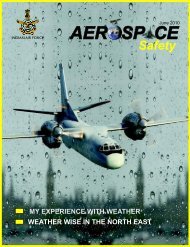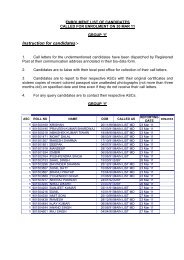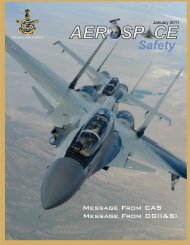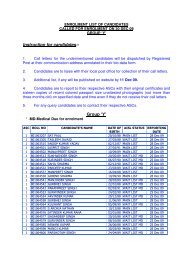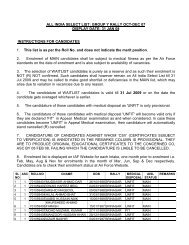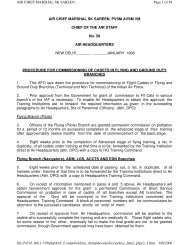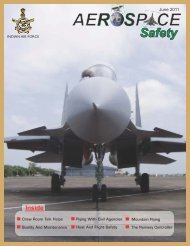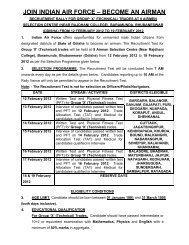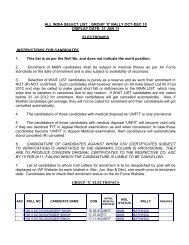November 2012 - Indian Airforce
November 2012 - Indian Airforce
November 2012 - Indian Airforce
Create successful ePaper yourself
Turn your PDF publications into a flip-book with our unique Google optimized e-Paper software.
airborne six minutes later as planned, to execute<br />
a planned rendezvous (RV) as a part of the sortie<br />
profile. They too contacted the SU, seeking to<br />
maintain 7000’ and 8000’ respectively to maintain<br />
safe height separation for the RV. Having levelled<br />
out at the allotted heights, the formation<br />
was permitted to change over to the training<br />
frequency by the Recovery Director (RD), who is<br />
the FC controlling local flying in the sectors, with<br />
an instruction to give ‘Ops normal’ call every ten<br />
minutes. It was only after about 7-8 min that the<br />
RD started getting perturbed when the formation<br />
started deviating from the track passed by the<br />
Base Ops Room. The RD could not check with the<br />
formation as they were on a different frequency<br />
and so asked the Recovery Assistant (air warrior<br />
detailed to assist the RD) to call up Base Ops<br />
Room and check the route.<br />
The fighter formation meanwhile had<br />
completed three legs of the route but had not<br />
effected the RV. The trail pair was together,<br />
trailing the lead pair by about 15 Km. As per<br />
the sortie profile, a bogie was simulated by the<br />
supervisor and the trail pair took tactical action.<br />
In the process, the Air Interception Radar of one<br />
of the ac picked up a track approaching from the<br />
right and after resuming course, the left member<br />
reported the civil airliner, after making visual<br />
contact. The right member ‘ducked down’ to<br />
create separation and the left member ‘pulled up’.<br />
The Gulfstream civil aircraft passed between the<br />
two ac with RA cutting in, asking the pilot to first<br />
pull up and then push down. Neither the civil ac<br />
nor the fighter formation was informed of each<br />
other’s presence.<br />
The RA is an audio warning, notifying<br />
imminent danger of collision, given by Traffic<br />
Collision Avoidance System on transponder<br />
equipped ac. When an RA is issued, the pilot is<br />
expected to respond immediately. He is allowed<br />
(at that time) to violate the ATS instructions given<br />
to him till the danger is over.<br />
The Mistakes Made / Questions to be Asked.<br />
In retrospect it is clear that mistakes were<br />
committed by many operators/functionaries in<br />
the chain for the situation to reach such unsafe<br />
levels. There are also some questions that arise.<br />
Some of them are listed below.<br />
Should the formation have stuck to its profile,<br />
now that it had got airborne during red period,<br />
given that at the newly decided heights, they<br />
were going to transgress into the airspace of ac<br />
operating in the sectors? It should also have been<br />
expected that the traffic in sectors would have<br />
been heavier as everyone had launched nearly<br />
together with the weather suddenly clearing up.<br />
While planning, ATS route crossing should<br />
have been as close to perpendicular as possible.<br />
Positive RT contact / clearance should have been<br />
taken from SU before crossing/approaching<br />
ATS route. Should the formation have been<br />
Continued on page 17<br />
INDIAN AIR FORCE 2 0 1 2 N o v e m b e r Aerospace Safety 13


